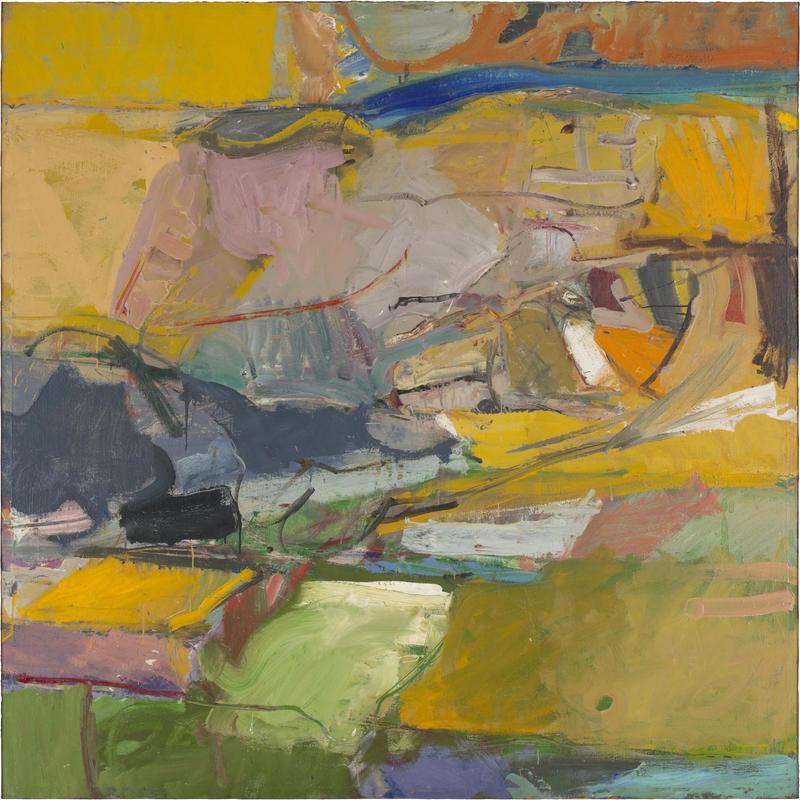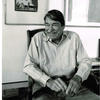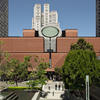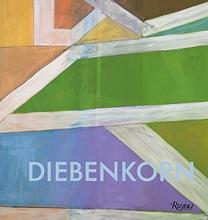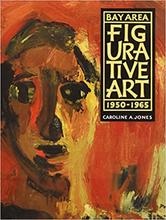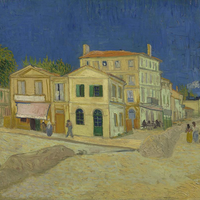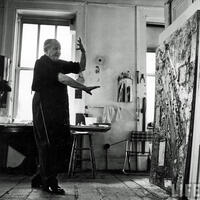More about Berkeley #57
- All
- Info
- Shop

Contributor
Richard Diebenkorn’s Berkeley #57 may look abstract at first glance, but could it also be that this is what Berkeley really did look like to most people in the 1960s?
All jokes aside, Diebenkorn lived in Berkeley for over a decade, from the mid 1950s straight through the 1960s. During those years, art was flourishing on the west coast. West Coast jazz and the Beat Generation of literature, including people like William Burroughs, Allen Ginsberg and Jack Kerouac, burst into the Northern California scene. Their fresh take on literature post World War II focused on spontaneity and non-conformism, and this almost certainly had a significant impact on Diebenkorn who was right in the artichoke’s heart of it all when he began to live and paint in Berkeley.
Diebenkorn painted in the flourishing abstract expressionist style, and his piece Berkeley #57 was completed in 1955. During his years in Berkeley, Diebenkorn was quick to build acclaim for his bright abstractions (like this one), which always seemed to show off fresh California settings and colors that weren’t being painted by anyone else. During his abstract expressionist phase especially, critics saw a clear influence of Cezanne on his work, and after his death he would pick up the title of “The Cezanne of California.”
His abstract work gained him enough fame that when he decided to turn toward more figurative works (shortly after Berkeley #57) for a significant portion of his time in Berkeley, people were openly contentious. When asked why he made the transition in an interview, he responded saying, “It was almost as if I could do too much too easily.” And so there you have it, Diebenkorn literally had so much talent that he felt like he had to switch up his entire approach in order to do less.
And it worked out brilliantly. Despite the early contention, figurative works like Coffee gained both acceptance and popularity.
The journey toward figurative art was a relatively short one though, and in a matter of years Diebenkorn moved back toward abstraction again, painting his most famous body of work inspired by the Berkeley seascapes near his home - 'The Ocean Park' series.
Sources
- Cumming, Laura. "Richard Diebenkorn Review – Gorgeous, Serious, Hard-won Work of a Lifetime." The Guardian. March 13, 2015. Accessed October 31, 2018. https://www.theguardian.com/artanddesign/2015/mar/13/richard-diebenkorn…
- Marable, Darwin. "Richard Diebenkorn, the Berkeley years, 1953-1966." World and I, Sept. 2013. Academic OneFile, http://link.galegroup.com/apps/doc/A350977330/AONE?u=nysl_me_newsch&sid…. Accessed 31 Oct. 2018.
- Pops, Martin. "Diebenkorn in the Age of Rauschenberg." Salmagundi no. 120 (Fall, 1998): 27-44. https://login.libproxy.newschool.edu/login?url=https://search-proquest-….
- Rosen, Aaron. "The Cézanne of California." Apollo, 05, 2015, 95-97, https://login.libproxy.newschool.edu/login?url=https://search-proquest-….
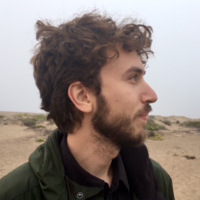
Contributor
The story behind Berkeley #57 begins in the deserts between Albuquerque and San Francisco.
And no, it’s not a story of cowboys and heists. That’s too clear-cut for an abstract expressionist like Diebenkorn. Instead, it’s about shapes and colors. It’s about patchworks.
In the summer of 1951, Diebenkorn took a plane from New Mexico to see an art show at the San Francisco Museum of Art. The plane flew unusually low over the valleys, and then even lower as it took an unscheduled dip into the gorge of the Grand Canyon. This low flight path allowed Diebenkorn a view of the Earth that he had never seen before.
He was astonished by it. He was astonished by the variety of textures and simple gridlines that existed on the surface of the deserts and plots of agriculture that he flew over. Shortly thereafter, he began experimenting with aerial photographs of landscapes. These photographs would go on to inspire his own landscape compositions, such as Berkeley #57.
The title Berkeley #57 feels like a bit of a misnomer, because the warm tones cut-up by strong lines are more suggestive of the country than of a dense urban area like Berkeley, California. In fact, you can almost hear the cows go moo in those thick fields of school bus yellow, then a pause, and then finally the full silence of the country. Yet the name of the painting is meant to highlight its abstraction rather than be suggestive of what it depicted. Because for Diebenkorn, it was all about presenting the feeling a space evoked rather than representing it.
For the pieces, Diebenkorn would go out for a drive in any direction until he saw a landscape he found compelling. Once he found it, he would return to his backyard studio in Berkeley to capture what he had felt and seen. This is how he painted nearly all of the fifty-eight paintings within the Berkeley series, with Berkeley serving as a type of geographical pinning that threaded the landscapes together. This gives Berkeley #57, and the series as a whole, a general impression of the topography and climate of the San Francisco Bay Area.
Shortly after Berkeley #57, Diebenkorn took an unexpected shift towards figurative landscapes due to a nagging feeling of restraint enforced upon him by abstract expressionism. But if you compare Seawall, perhaps his most famous figurative landscape, with Berkeley #57, you begin to wonder about how much constraint Diebenkorn really felt. Abstraction was natural to him, just like the desert patchworks he saw on that fateful plane ride.
Sources
- Nash, Steven A., Timothy Anglin. Burgard, Emma Acker, and Richard Diebenkorn. Richard Diebenkorn: The Berkeley Years, 1953-1966. San Francisco, CA: Fine Arts Museums of San Francisco, 2014.
- Livingston, Jane. The Art of Richard Diebenkorn: Whitney Museum of American Art, New York,. New York: Whitney Museum of American Art, 1997.
- "Oral History Interview with Richard Diebenkorn, 1985 May 1-1987 December 15." Interview by Susan Larsen. October 3, 2005. Accessed October 2018. https://www.aaa.si.edu/collections/interviews/oral-history-interview-ri….

